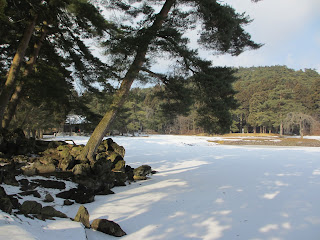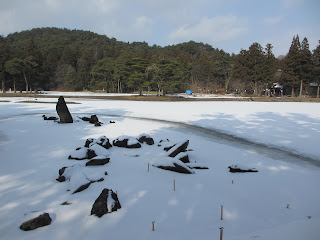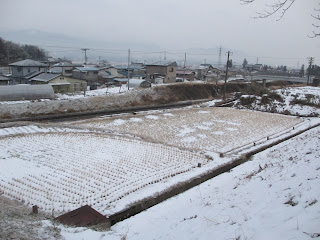 |
| Entrance to the main temple area |
After
rusticating in our onsen, it was time for some historical sight-viewing. As you may gather from this website, I am really serious about seeing places of cultural/historical significance when traveling (honestly it is pretty much all the time, but on vacation I usually have more free time). My idea of the perfect vacation is 12-hour days spent exploring ancient ruins, interspersed with museum visits.
B is not as big a fan, but luckily for me he is pretty tolerant and willing to spend hours looking at (historically significant!!!) dirt pits and piles of rubble. (His mother also loved this kind of thing, to the point that B and his brother used to call her a "ruinaholic", so I guess he had some home training). Northern Japan has only one UNESCO world heritage site so naturally we had to visit it.
The site is Hiraizumi, which over a thousand years ago was the capital of the Fujiwara clan. They ruled about a third of Japan (technically owing allegiance to the emperor far away in Kyoto, but actually doing just as they liked). The rulers were devout Buddhists (Buddhism was a relatively recent import to Japan at the time) and designed their capital to represent the Buddhist paradise (or "Pure Land"). This didn't only extend to the buildings, but the very landscape: every tree and rock was deliberately placed, and they even artificially raised the height of the nearby mountain.
 |
| This is an enormous artificial lake, created according to Buddhist cosmological principles |
 |
| All the rocks have been imported at great expense from far away, then carefully arranged to look this way |
 |
| The river is artificially-created too (the bends are there on purpose, to give it a certain look) |
 |
| In the summer, they have a traditional Heian poetry contest here, where glasses of sake are floated down the river from poet to poet: they must complete a line of verse before the cup reaches them, then take a sip |
 |
| It's still an active temple complex, with very famous religious rites held annually (they date unchanged from its founding) |
 |
| More carefully placed rocks (with artificially heightened hill in the background): the Japanese sense of landscape design, even 1000 years ago, is very different from the Western one |
 |
| Another garden/temple complex, with another artificial lake and rocks |
 |
| Very rustic torii (these gates mark the entrance to sacred ground) and the path to the artificially-heightened hill |
 |
| Shrine at the top: supposedly sutras were buried here. The graves of Yoshitsune's family (murdered for political reasons) are at the bottom of the hill. |
The Fujiwaras could do this because they controlled all of Japan's gold resources, which made them fantastically wealthy. The capital became a cultural and religious center, attracting visitors, pilgrims and scholars from all over, and its fame spread even wider. In fact, the main temple of Hiraizumi, Chusonji, gave its name to the whole country (Chuson-ji became Cipangu, the name Marco Polo calls Japan, and over time this became the modern name).
 |
| Main hall of Chuson-ji |
 |
| The "Golden Hall", where a wooden temple entirely covered in gold (containing the mummies of the rulers) resides. No pictures are allowed inside but it is impressive in its beauty and the incredible expense obviously involved. |
 |
| Japanese equivalent of a log cabin: where a famous priest resided when visiting |
 |
| Noh theatre stage, where traditional plays are still performed |
 |
| Shrine: Japanese temples are usually of unadorned wood |
The state of affairs did not last, ending when the ruler offered sanctuary to the unfortunate
Yoshitsune (a brilliant general, he had won the recent civil war for his brother Yoritomo, who returned the favor by outlawing him and seeking to kill him). Yoritomo then declared war on the Fujiwaras (even though Yoshitsune committed suicide before the war started) and they were defeated: the city itself was not destroyed, but it lost all its relevance and entered a long, slow decline. The story of Yoshitsune is immensely popular in Japan (the archetypal tragic hero: he was supposedly a paragon of virtue).
 |
| Gravestone and Buddha (they often dress Buddha statues in hats and bibs) |
 |
| Frog statue covered in snow |
 |
| The countryside is beautiful, full of pines covered in snow |
 |
| Bamboo, pine and a torii: this is the Japan of my imagination |
 |
| Shrine to Yoshitsune's lieutenant Benkei (think Robin Hood and Little John) |
Many of the buildings of Hiraizumi were destroyed over the next millennium, but enough remain (including Chuson-ji) to make fascinating viewing. The 1000-year-old gardens have been preserved too (the only remaining ones in Japan). There are also several museums (including one associated with an archaeological site of the administrative buildings of the Fujiwara).
 |
Yoshitsune's grave is on a hill just beyond the town: the poet Basho wrote the famous haiku:
"The summer grasses/All that remains/Of brave soldiers' dreams" when visiting it in 1689 |
 |
| It's really rural now: here's some rice fields right in the center of town |
I saw everything in great, painstaking detail (I like to read every placard and visit every point of interest), because B was kind enough to amuse R for two days. (They went to
Yamadera Temple on a daddy-daughter trip, which sadly I don't have any pictures of, as we only had one camera.) Thanks B for being so supportive of my interests! He is a great husband.
 |
| I lunched on a form of soba (buckwheat noodles) which is a specialty of the region: you are served unlimited small portions of soba (the bowls on trays to the left), then flavor to your own taste with the included toppings (on the tray to the right). Toppings include pickled ginger, caviar, onions, pickled vegetables, shaved radish, raw fish, dried fish, various sauces, etc. |
 |
| The restaurant I ate at (it got really crowded shortly thereafter with dozens of Japanese slurping noodles at a tremendous rate: people take pride in how many bowls they can pack away. The waitress teased me because I could only eat 1.5 trays.) |
No comments:
Post a Comment